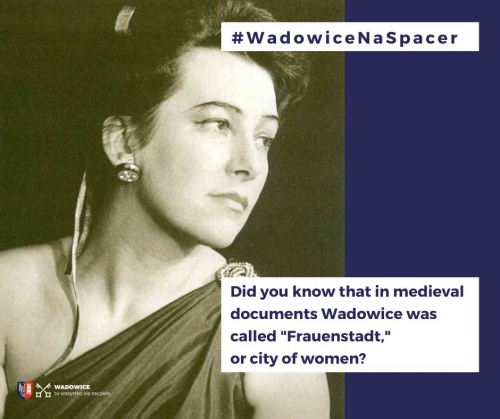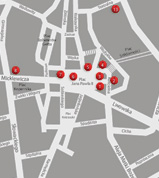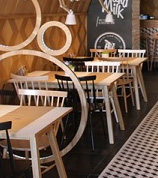
#WadowiceNaSpacer or a Walk in the footsteps of women in Wadowice
This time, together with #WadowiceNaSpacer, we encourage you to head into the town, following the footsteps of extraordinary women who have made their mark in our history. Did you know that in medieval documents Wadowice was called "Frauenstadt," or city of women? In our list you will find exceptional and extraordinary figures who left their mark on both the local community and the whole country.
A Walk in the footsteps of extraordinary women is a great way to spend a summer afternoon. A google map we have prepared will help you: https://www.google.com/maps/d/edit?mid=1_RePUpvYWEeGsJaIK6hxJru2euMPVnU&usp=sharing
- Princess Agnieszka – Basilica of Presentation of the Blessed Virgin Mary in Wadowice
Princess Agnieszka (1477/1480 – 1505) was the daughter of Duke Władysław of Zator and Duchess Anna. In 1492 her father granted his wife Anna a lifelong reign over Wadowice, along with the holdings and the rights to inherit the town for their daughter. In 1494 the ecclesiastical court in Cracow declared the marriage of the princess’ parents invalid, and the offspring from this union were deprived of the inheritance rights. The duke was succeeded by the King of Poland in accordance with earlier agreements,. After her father’s death, Agnieszka took possession of Wadowice without waiting for the court’s verdict. Eventually the will of Włodek from 1492 was declared invalid and Agnieszka was considered only a tenant (leaseholder) of the town, whose authority was temporary and illegitimate. The princess was married to Jan Kobierzycki of Odrowąż coat of arms. Their only son, Ernest, did not claim the right to Wadowice after his mother’s death. In 1503, the King of Poland granted Wadowice to Piotr Myszkowski, the Łęczyca voivode. Agnieszka was opposed to this and did not leave the town despite a royal court sentence issued in 1504. The execution of the sentence was carried out by Mikołaj Kamienicki of Kamieniec. Shortly after the princess passed away and her funeral took place in 1505 in Wadowice, where she was buried. As late as 1552 there was a tombstone in the Wadowice parish with the inscription: "In the year of our Lord 1505 died the serene Duchess Agnieszka, by God's grace Duchess of Zator and Lady of Wadowice, benefactor of this church, pray for her."
- Maria Gedl – The Gedl Family Tenement House, ul. Kościelna 4 Wadowice
Maria Gedl (1865-1947) was a townswoman and housewife, as well as heir to the Schwartz estate. She was born in 1865 in Lviv to Rudolf Schwartz, a merchant, musician and director of the Conservatoire. The family owned property in Frydrychowice (‘’Szwarcowizna”) and in Wadowice (including a salt house, town manor and two gardens). In 1884, Maria married Mieczysław Gedl, a doctor, and they settled in Wadowice. They lived in a tenement house at ul. Kościelna 4, which was part of the vast Schwartz estate. At the time, Maria was in charge of running the house, which became the center of the town’s social and intellectual life. After her husband’s death in 1901, she raised 5 children alone and managed the family estate. She lived to a ripe old age in her apartment. She died in 1947 and was buried in the parish cemetery in Wadowice.

Photo from the collection of the Town Musem in Wadowice.
- Anna Huppert – Tenement House, ul. Zatorska 2
Anna Huppert (approx. 1852-1942) was a president of the Jewish Ladies’ Association and grandmother of Jerzy Kluger, a childhood friend of Karol Wojtyła. Anna and her husband Izrael Huppert – president of the kehilla and town councilman – lived in a tenement house at the corner of Town Square and ul. Zatorska. There they ran a so-called propination, or licensed sale of spirits. This made them one of the wealthiest families in the town. For many years (until 1919) Anna was the president of the Ladies’ Association, a Jewish organization dedicated to caring for women before and during childbirth and providing them with material, medical and spiritual assistance. Anna lived in her home with her daughter Rozalia and her family (her husband Wilhelm Kluger – a lawyer and president of the Jewish community – and her two grandchildren Antonina and Jerzy). After the outbreak of World War II, Anna, her daughter Rozalia and her granddaughter Antonina were placed in Wadowice ghetto (today’s Plac Bohaterów Getta). As a result of a selection by the Nazi Germans in 1942, at the age of 90, she was sent to the Bełżec extermination camp, where she was murdered.
- Janina Zagórska – Tenement House, Plac Jana Pawła II 10
Janina Zagórska (1896 -1952) was a pianist and music teacher. She was born in 1896 in Zator. She was a student of the secondary school in Lviv, later in Mielec, and of the private H. Strażyńska secondary school in Cracow. In 1914, she married Mieczysław Zagórski, an engineer, with whom she moved to Wadowice at the turn of 1920/1921 and settled in a tenement house on Market Square. During this time, Janina practised playing piano. When she mastered it, she opened a private school in her apartment, offering lessons on how to play the piano. Her life during the interwar period was not just about music. Since 1927 she was a member of the Wadowice branch of the Babia Góra Division of the Polskie Towarzystwo Tatrzańskie (Polish Tatra Society). The occupation and hard work strained the health of her husband, who died in 1952, wheras Janina taught piano all the time. At the end of each year a showcase of her students’ skills was held in the theater room of the House of Culture. Zagórska died in 1973 and was buried in the family tomb, alongside her husband. Her grand piano, on which she played during concerts, was donated to the State School of Music in Wadowice, which was being established at the time.

Photo from the collection of the Town Museum in Wadowice
- Janina Brzostowska –Marcin Wadowita High School ul. Mickiewicza 16
Janina Brzostowska (1897 – 1986) was a poet and a translator of literature from Wadowice. Her mother was a pianist and her father was the principal of a Wadowice high school, a poet and an expert in Polish and classical literature. She deepened her love for classical literature and her native native language at the Wadowice high school. She debuted on the pages of the school newspaper "Nasz łan" and acted in several productions of the school theater. Between 1917 and 1922 she studied Polish and Romance studies at the Faculty of Philosophy of the Jagiellonian University. Discovered by the "Czartak" poets, she made her debut on the pages of their almanac in 1925. She published a total of 18 volumes of poetry. In 1938-39 she was the editor of the magazine "Skawa". Her translation of Safona’s Songs from Greek was a success. Janina was also a co-founder of the International Academy of Poetry in Cambridge, England. She died in Warsaw in 1986. Lviv Polytechnic honored her with an honoris causa honorary degree, and her hometown honored her memory by naming one of its streets after her.

Photo of the Portrait of the poetess by S.I Witkiewicz, 1939, private collection
Halina Królikiewicz-Kwiatkowska (1921- 2020) was a theater and film actress. She was born in Bochnia as the daughter of a high school pedagogue, Jan Królikiewicz (a classical philologist). She settled in Wadowice in 1934, when her father became the principal of a male high school. Halina was a student at the female high school at the time when Karol Wojtyła was a student at the male high school. Together they acted in the school’s amateur theater, including Sophocles’ "Antigone." After graduating, she and Wojtyła dreamed of a great acting career. In 1938, they both began studying Polish philology at the Jagiellonian University. Nvertheless, they continued to devote their free time to acting. During the war, both were members of Mieczysław Kotlarczyk’s Rhapsodic Theater troupe. One of its members was Halina’s later husband, writer and publicist, Tadeusz Kwiatkowski. As a professional actress, Halina made her debut in a of J. Słowacki’s production "Król Duch" precisely at the Rhapsodic Theater. After the war, she performed for many years at the National Old Theater and the J. Słowacki Theater. She also played in films by A. Wajda and Wojciech J. Has. For forty years she was a pedagogue at the Academy of Theater Arts in Cracow. She was awarded, among other, the Knight’s Cross of the Order of Polonia Restituta and the Gold Medal „Merit to Culture - Gloria Artis” She died in 2020 in Warsaw at the age of 99. She was buried in the military cemetery on ul. Prandota in Cracow.

Photo from the book by H. Kwiatkowska, "Porachunki z Pamięcią", Kraków 2002
- Wanda Krahelska-Dobrodzicka – District Court in Wadowice, ul. Żwirki i Wigury 9
Wanda Krahelska-Dobrodzicka (1886-1968) was a political and social activist, artist and publisher. In 1906 after an unsuccesful bombing attempt on the Russian Military Governor of Warsaw - General Jerzy A. Skałłon, she fled to Galicia. In 1907 she was captured by Austrian police at the explicit intervention of the Russians. Earlier she had married an artist from Wadowice – Adam Dobrodzicki. This made extradition of her person impossible and the trial had to take place in the Austro-Hungarian state. The court session took place in Wadowice on the 17th and 18th of February 1908. Crowds of people who came to Wadowice waited for the freed Polish heroine in front of the court building. At the time a makeshift wooden triumphal gate awaited Krahelska ,who was leaving the court building, through which she was carried away by the crowd. After the trial she began her studies at the School of Fine Arts in Cracow, later she studied art history at the Jagiellonian University and from 1911 studied at the Florence Academy of Fine Arts. In 1942 during World War II she founded the Provisional Committee to Aid Jews (Żegota) together with writer Zofia Kossak-Szczucka. For her attitude, she was awarded the Medal of the Righteous Among the Nations in 1967. She died in Warsaw in 1968.
- Halina Walkiewicz-Malofiejew – County Hospital Jana Pawła II ul. Karmelicka 12 (non-existing building)
Halina Walkiewicz-Malofiejew (1906-1981) was a doctor and pioneer of cythopathology. She was born in 1906 in Samara, Siberia. During her medical studies in Vilnius, she met her future husband, doctor Sergiusz Malfojew. From 1938 to 1945 she worked in the department of obstetrics and gynecology at the St. Jacob’s Clinical Hospital in Vilnius. After the Red Army entered Vilnius, her husband was arrested and deported to Siberia. In the summer of 1945 Halina and her children were repatriated to Poland. She settled in Wadowice and began working at the County Hospital in the gynecology and obstetrics department. At the time she worked with the facility’s director, Dr. J. Sołtysik (a surgeon) and Dr. Romaszkan (a radiologist). By night, she treated the wounded partisans in the middle of the woods on numerous occasions. During this period, she graduated from the Central Doctors’ Training Course in Warsaw and was the first to receive the first and the second degrees of specialization in obstetrics and gynecology. In Warsaw, she became interested in cytopathology of the reproductive organs, and it was then that the idea of creating a specialized laboratory was born. In 1958 Halina and her family moved to Grodzisk Mazowiecki, where she became the head of the County Hospital. There she organized the cytopathology laboratory she had dreamt of. She was one of the first to begin research on the preventive treatment of reproductive organs. After the war, she learned that her husband had survived the Gulags, but never returned to Poland for fear of reprisals. The couple met in 1962 in England. Halina died in 1981 and was buried at the Dojlidy cemetery in Białystok.

Photo from article by H. Kozłowska "W cieniu syna", magazine "Czasopis” 1/05, page 28-32.
- Magdalena Strzelecka – House of Divine Providence of the Congregation of the Sisters of the Holy Family of Nazareth, ul. Lwowska 31
Magdalena Strzelecka (1935 – 2020) was a Nazareth nun and curator of the Papal Museum. She was born in 1935 in Szczekociny as Daniela Strzelecka. After graduating secondary school, she entered the Congregation of the Sisters of the Holy Family of Nazareth in Kielce. From 1959 she studied at the Higher Catechetical Institute and later at the Pontifical Academy of Theology in Cracow. After Piekoszów and Cracow, Wadowice was another catechetical institution for the Sister. She first worked in a nursing home run by the Sisters, and then as a catechist for another 25 years. She received a medal for her major contribution to the formation and religious education of many generations of Wadowice residents. Between 1984 and 2010, together with three other sisters, she guided tourists and pilgrims to the Family Home of Saint John Paul II. Sister also frequented the Vatican. Thanks to her friendship with the sisters of the Congregation of the Servants of the Sacred Heart of Jesus, who served the Holy Father, the Museum of the Family Home of the Holy Father John Paul II received priceless gifts, that are now on display. In 2008 she was honored by the President of Poland for her involvement in organizing papal visits and contributing to keeping the papal spirit alive in the region. She died in 2020 and was buried in the Wadowice parish cemetery.

Photo from the collection of the Town Museum in Wadowice
- Ada Sari – tenement house ul. Lwowska 3
Ada Sari (1886-1968) was an opera singer, actress and pedagogue. She was born in 1886 in Wadowice as Jadwiga, daughter of attorney Edward Szayer. At the age of 3 she and her family moved to Stary Sącz, where her father worked as a lawyer and from 1920 to 1930 as a mayor. Ada studied at the secondary school in Cieszyn and then in Cracow, where she began singing lessons in 1903. She later attended a private music school in Vienna. Her first public performance is considered to be a concert at Duchess’ of Lichtenstein in 1906. From 1907-09 she trained her voice with Antonio Rupnicka in Milan. In 1909 she made her debut on the stage of Teatro Nazionale in Rome. The peak of her career came during her years with the La Scala Theater in Milan, where she took part in the production of Mozart’s opera "The Magic Flute" in the role of the Queen of the Night, among others. She sang in 11 languages, triumphing on the stages of Europe and the world. After the war, she found fulfillment primarily as a pedagogue, teaching singing classes at the State Higher School of Music in Cracow and Warsaw, among other places. She died in 1986 in a sanatorium in Ciechocinek after suffering a heart attack. She was buried in the Avenue of Notables at Powązki Cemetery in Warsaw.

Fot. Biblioteka Narodowa, polona.pl
Photo: National Library, polona.pl
#Wadowice #WadowiceMunicipality #WomenHistory #OnTheWalk #herstory

.png)






